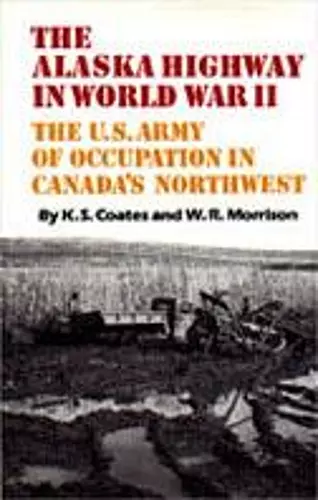The Alaska Highway in World War II
The U.S. Army of Occupation in Canada's Northwest
Ken Coates author Robert W Morrison author
Format:Hardback
Publisher:University of Toronto Press
Published:7th Nov '92
Currently unavailable, and unfortunately no date known when it will be back

After the Japanese attack on Pearl Harbor a general fear of invasion swept North America, and particularly the West Coast; it seemed essential that immedtiate steps be taken to defend the Far Northwest. With the approval of the Canadian government, Washington drew up plans for the future Alaska Highway to connect Edmonton, Alberta, with Fairbanks, Alaska, and for a pipeline to connect the oil fields at Norman Wells, Northwest Territories, with the Pacific Coast. As a result, between 1942 and 1946, forty thousand American military and civilian personnel invaded the Canadian Northwest.
Where there had been few roads or none, a pioneer road more thant 1500 miles long was built in less than a year. A rough road was built from Normal Wells to Whitehorse, Yukon ( a distance of nearly 600 miles), and the Canol Pipeline was built along its length. Navigation facilities along the Mackenzie River were improved. Pipelines were laid from Whitehorse northwest 600 miles to Fairbanks; southest 300 miles to Watson Lake, near the British Columbia line; and southwest 100 miles to the Pacific Ocean at Skagway, Alaska. The Haines Lateral, almost 150 miles long, connected the Alaska Highway to salt water at Haines, Alaska. Existing airfields were upgraded and new ones built on the Northwest Staging Route. Ancilary facilities, such as a telephone network, were constructed.
The Northwest was totally unprepared for this friendly invasion. The AlaskaHighway ran through a semiwilderness where many inhabitants pursued a nomadic, harvesting way of lie. More thanb 5,000 trucks arrived where there had been hardly that many pepoel. Edmonton, with 95,000 people, became "the young Chicago of the North." Whitehorse, an obscure village of fewer than 800 people, was to become northern Canada's largest community and the territorial capital. Many other small towns and settlements were overwhelmed by the tens of thousands in the American "army of occupation."
This lively history of a great episode in American civil and military engineering is based largely on interviews with veteran and local residents, as well as research in Canadian archives and those of the U.S. Corps of Engineers.. The authors address such related topics as how and why the projects were planned and built; the impacts of the newcomers on the environment, the wildlife, and...
'Coates and Morrison are the undoubted experts on the history of the North, and here they have done original research into a host of new areas. They offer intelligent discussion of the problems of maintaining law and order in a vast and under-policed region that was suddenly transformed by the arrival of thirty thousand foreigners. The RCMP's strength in the North was derisory, the U.S. Army's Military Police were ordinarily insensitive, and there were the inevitable problems when men sought sex and liquor or a fast buck..'
-- J.L. Granatstein * BC StudiISBN: 9780802050236
Dimensions: 224mm x 149mm x 30mm
Weight: 610g
309 pages